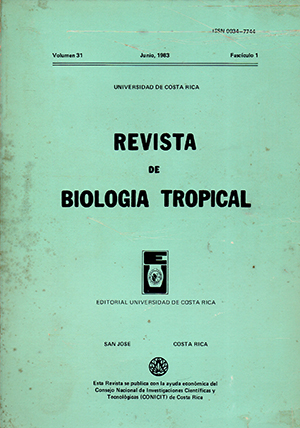Abstract
This is a preliminary study of the Pejibaye (Bactris gasipaes) frond and begins with a general morphological description of the Icaf, complementing those already in existence. The data obtained from Central American Pejibayes show that the rachis length of their fronds is considerably longer than those recorded from Surinam populations and it is assumed that at least part of this difference has a genotypic background. It was also found, contrary to expectations, that the older fronds have a longer rachis than younger mature ones from the same trunk. This difference could be due to seasonal environmental factors such as variations in rainfall. The association of leaflets in groups, each leaflet having a different angle of insertion on the rachis within the group, gives a many-planed leaflet arrangement that may increase light-use efficiency. The groups are formed by a variable number of leaflets and consequently are not a reliable character for use as a descriptor. The many-planed arrangement fades in old fronds when drooping of the leaflets increases, obscuring the effect of the different angles of insertion. It was also found that assymetry exists between opposite sides of the same frond in regard to leaflet number and length. An assymetrical frond outline is evident on both sides of the frond. A larger leaflet number was found in the younger fronds when compared with the older ones from the same plant in spite of the longer rachis of the latter ones. This may indicate that even 12 year-old palms have not reached the maximum development of their fronds since it is assumed that leaflet number is less affected by environmental variations than rachis length.References
Barbosa Rodrigues, J. 1903. Sertum Palmarum Brasiliensium. Vol. 11: 46-50. Tipographique Veuve Monnom, Bruxelles.
Broekmans, A.F.M. 1957. Growth, Flowering and Yield of the Oil Palm in Nigeria. J. W.A.I.F.O.R., 2: 187-220.
Corley, R.H.V., & B.S. Gray. 1976. Growth and Morphology, 531 p. In R.H.V. Coriey, J.J. Hardon, & B.J. Wood (eds.). Gil Palm Research. Elsevier Sci. Publ. Co., Amsterdam.
Davis, T.A. 1968. Bilateral Symmetry in the Leaves of Cocos nucifera L. FAO. 3rd. Tech. Work-Party on Coconut Prod. Prot. & Proc. Jogjakarta. 7 p.
Hardon, J.J., C.N. Williams, & I. Watson. 1969. Leaf Area and Yield in the Oil Palm in Malaya. Exp. Agric., 5: 25-32.
Hartley, C.W.S. 1977. The Gil Palm (Elaeis guineensis Jacq.). Longman, New York. 806 p.
Humboldt. A., A. Bonpland, & C.S. Kunth, 1815-1825. Nova genera et species plantarum. Lutetiae Parisiorum. Paris. 7 Vol.
MacBride, J.J. 1960. Bactris gasipaes H.B.K. In: Flora of Peru. Field Mus. Nat. Hist. Bot. Series Vol. 13, pt. 1, # 2, Publ. 895.
Martius, C.F.P. von. 1824. Historia Naturalis Palmarum. 2: 81-83.
Mendham, N.J. 1971. Note of Leaf Area Measurement in Oil Palms. Papua New Guinea Agric. J., 22: 230-231.
Mora Urpí, J. & C.R. Clement. 1981. Aspectos Taxonómicos Relativos al Pejibaye (Bactris gasipaes H.B.K.) Rev. Biol. Trop., 29: 139-142.
Morera Monge, J .A. 1981. Descripción Sistemática de la "Colección Panama" de Pejibaye (Bactris gasipaes H.B.K.) de CATIE. Tesis M.Sc. CATIE, Turrialba. 122 p.
Nixon, R.W. 1950. Imported Varieties of Date in the United States. USDA Circular # 834. 144 p.
Tomlinson, P.B. 1961. Anatomy of the Monocotyledons. II. Palmae. Edited by C.R. Metcalfe. Oxford. 453 p.
Wessels-Boer, J.G. 1965. Indigenous Palms of Suriname. Leiden E.J. Brill. 106. p.
##plugins.facebook.comentarios##

This work is licensed under a Creative Commons Attribution 4.0 International License.
Copyright (c) 1983 Revista de Biología Tropical


